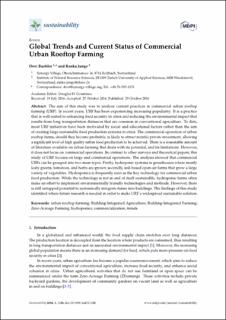Please use this identifier to cite or link to this item:
https://doi.org/10.21256/zhaw-1591| Publication type: | Article in scientific journal |
| Type of review: | Peer review (publication) |
| Title: | Global trends and current status of commercial urban rooftop farming |
| Authors: | Bühler, Devi Junge, Ranka |
| DOI: | 10.21256/zhaw-1591 10.3390/su8111108 |
| Published in: | Sustainability |
| Volume(Issue): | 8 |
| Issue: | 11 |
| Page(s): | 1108 |
| Issue Date: | 2016 |
| Publisher / Ed. Institution: | MDPI |
| ISSN: | 2071-1050 |
| Language: | English |
| Subjects: | Zero-acreage farming; Building-integrated agriculture; Hydroponics |
| Subject (DDC): | 630: Agriculture |
| Abstract: | The aim of this study was to analyze current practices in commercial urban rooftop farming (URF). In recent years, URF has been experiencing increasing popularity. It is a practice that is well-suited to enhancing food security in cities and reducing the environmental impact that results from long transportation distances that are common in conventional agriculture. To date, most URF initiatives have been motivated by social and educational factors rather than the aim of creating large sustainable food production systems in cities. The commercial operation of urban rooftop farms, should they become profitable, is likely to attract notable private investment, allowing a significant level of high quality urban food production to be achieved. There is a reasonable amount of literature available on urban farming that deals with its potential, and its limitations. However, it does not focus on commercial operations. In contrast to other surveys and theoretical papers, this study of URF focuses on large and commercial operations. The analysis showed that commercial URFs can be grouped into two main types: Firstly, hydroponic systems in greenhouses where mostly leafy greens, tomatoes, and herbs are grown; secondly, soil-based open-air farms that grow a large variety of vegetables. Hydroponics is frequently seen as the key technology for commercial urban food production. While the technology is not in and of itself sustainable, hydroponic farms often make an effort to implement environmentally friendly technologies and methods. However, there is still untapped potential to systemically integrate farms into buildings. The findings of this study identified where future research is needed in order to make URF a widespread sustainable solution. |
| URI: | https://digitalcollection.zhaw.ch/handle/11475/2351 |
| Fulltext version: | Published version |
| License (according to publishing contract): | CC BY 4.0: Attribution 4.0 International |
| Departement: | Life Sciences and Facility Management |
| Organisational Unit: | Institute of Natural Resource Sciences (IUNR) |
| Appears in collections: | Publikationen Life Sciences und Facility Management |
Files in This Item:
| File | Description | Size | Format | |
|---|---|---|---|---|
| 2016_Buehler_Global trends and current status_Sustainability.pdf | 1.14 MB | Adobe PDF |  View/Open |
Show full item record
Bühler, D., & Junge, R. (2016). Global trends and current status of commercial urban rooftop farming. Sustainability, 8(11), 1108. https://doi.org/10.21256/zhaw-1591
Bühler, D. and Junge, R. (2016) ‘Global trends and current status of commercial urban rooftop farming’, Sustainability, 8(11), p. 1108. Available at: https://doi.org/10.21256/zhaw-1591.
D. Bühler and R. Junge, “Global trends and current status of commercial urban rooftop farming,” Sustainability, vol. 8, no. 11, p. 1108, 2016, doi: 10.21256/zhaw-1591.
BÜHLER, Devi und Ranka JUNGE, 2016. Global trends and current status of commercial urban rooftop farming. Sustainability. 2016. Bd. 8, Nr. 11, S. 1108. DOI 10.21256/zhaw-1591
Bühler, Devi, and Ranka Junge. 2016. “Global Trends and Current Status of Commercial Urban Rooftop Farming.” Sustainability 8 (11): 1108. https://doi.org/10.21256/zhaw-1591.
Bühler, Devi, and Ranka Junge. “Global Trends and Current Status of Commercial Urban Rooftop Farming.” Sustainability, vol. 8, no. 11, 2016, p. 1108, https://doi.org/10.21256/zhaw-1591.
Items in DSpace are protected by copyright, with all rights reserved, unless otherwise indicated.